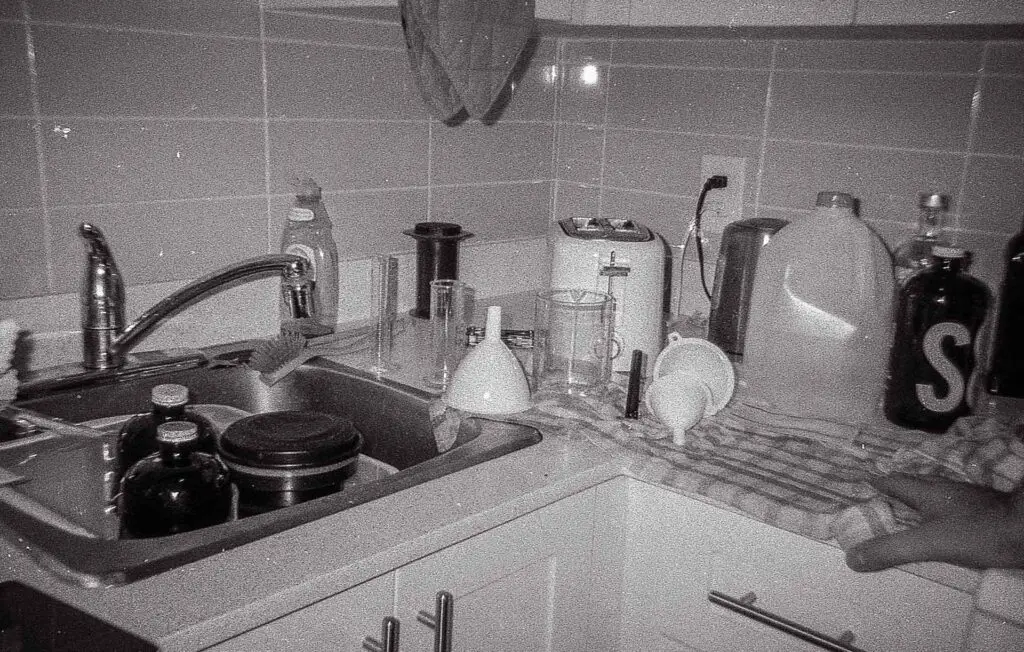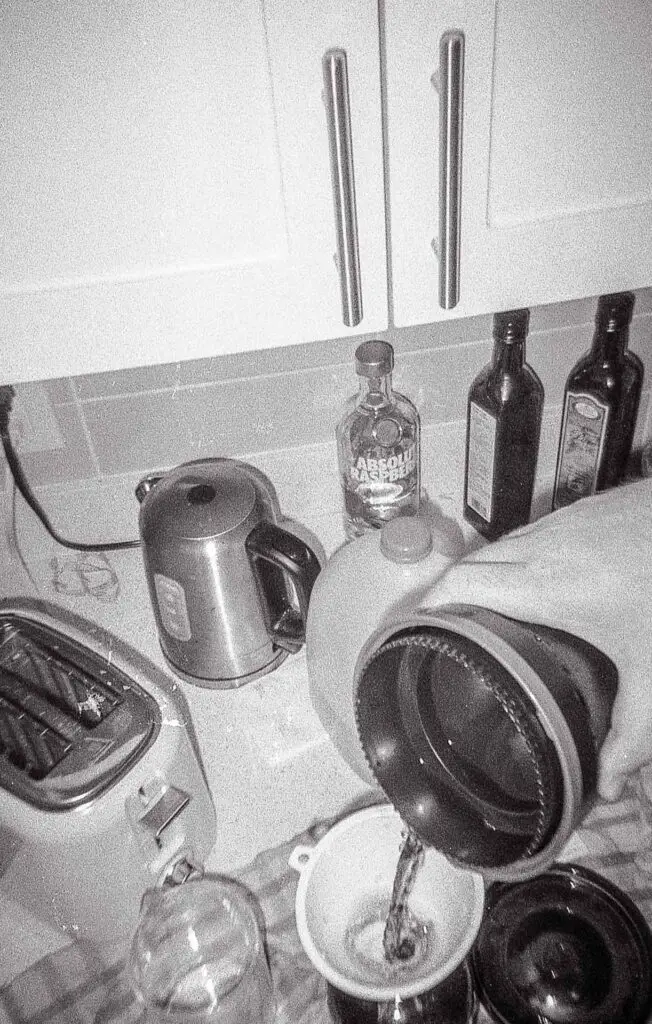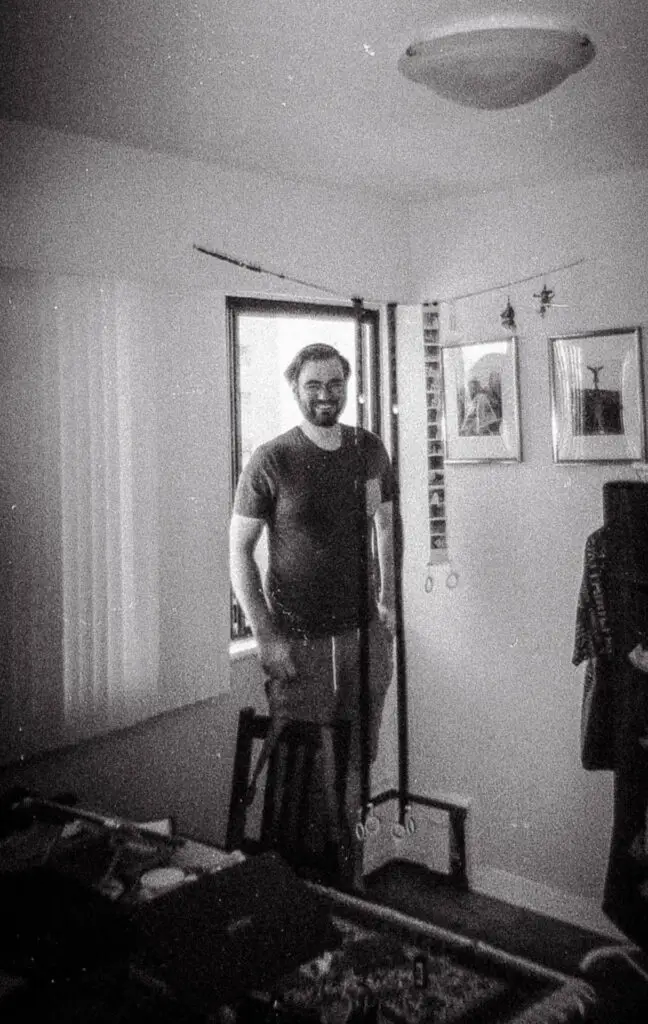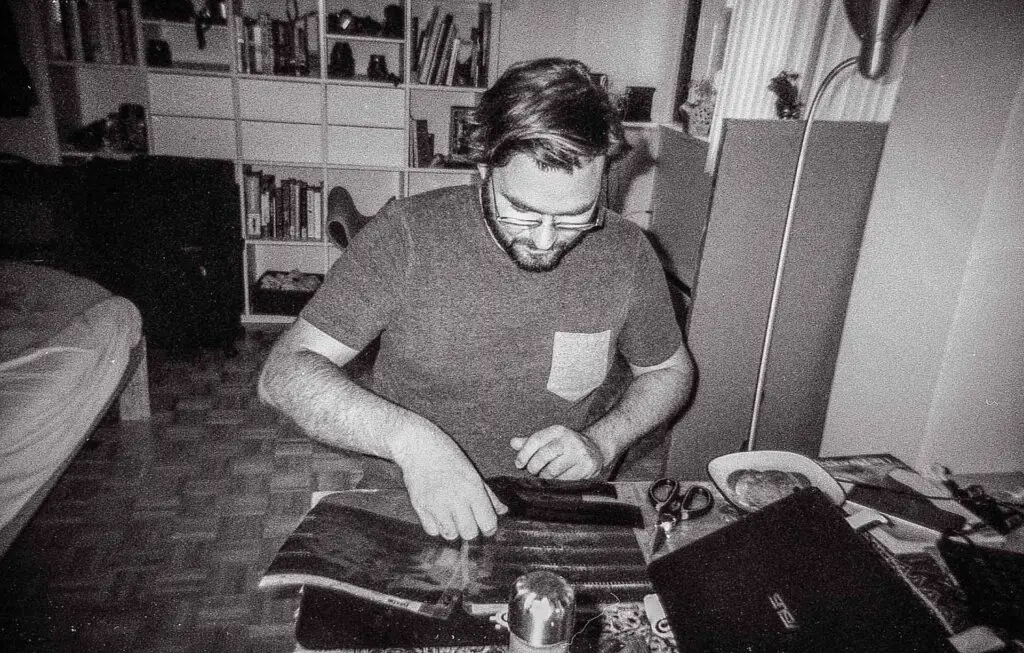I have chronic eczema, and I’ve been developing film for a couple of years now. These chemicals are harsh, but with a couple of tips, it’s fairly easy to develop film without getting the eczema-inducing chemicals on your skin. Most people will tell you ‘just wear gloves and you’ll be fine.’ And they’re right — at least partially. Anyone who has eczema, before ever entering the darkroom, knows it’s not quite that simple. Even with gloves, my hands still come out dry and smelling like fixer, and sometimes have eczema breakouts. But I’ve learned a number of ways over the years to reduce those chances.
Even if you don’t have eczema, chemicals in the darkroom can cause eczema-like skin reactions. A study of darkroom printers in Tehran found that 37% had some skin issues, like leukodermas, eczema, lichen-planus, or lichen-planus-like eruptions that developed from contact with darkroom chemicals. The study also asked how many of them wore gloves in the darkroom. It found that there was an 80% chance those who refused gloves had developed a skin disease relating to the development process!
If you have eczema, it’s important to have a lab coat to reduce the number of darkroom chemicals splashing onto your clothes. They protect your arms and your clothing from spills, which can stain, and they look pretty damn cool doing it. If you don’t have a lab coat, I would highly recommend purchasing one. These are cheap and exceptionally effective at reducing the number of chemical spills that make it through to your skin. Here’s one that I’ve used on Amazon.

What is the best film developer for people with eczema?
The developer and fixers are very harsh on skin for eczema sufferers. The best developers for eczema will omit hydroquinone from their formulas, as it’s one of the chemicals that takes the biggest toll on skin for eczema sufferers. This means the best option for film is Kodak D-76, and Legacy Pro Eco B&W Paper developer. But even these chemicals need to be handled with care for people with eczema.
Legacy Pro also makes an eco-friendly fixer that is a good solution for people with eczema. Their fixer doesn’t use any hydroquinone, borates, or metol in the working solution, and still produces archival-quality film and prints. The legacy pro fixer is odourless, and has a longer shelf-life than standard rapid-fixers. The neutral formula also has the benefit of not needing a rinse after the acid stop bath, reducing water consumption during the developing process.
If you get fixer or developer on your skin, it’s important to wash it off as quickly as possible with soap and water. Just like Technical Data Sheets, every single film chemical will have its own MSDS, which will contain all of the relevant health information and chemical compounds present.
What kind of gloves are recommended for people with eczema?

I dislike gloves for many reasons. I lose tactile senses, liquids end up inside, and they get sweaty real fast. But without them, I run the risk of developing terrible patches of eczema. So they’ve become a necessary evil in my workflow. Over time, I’ve found that some gloves are better than others.
Absolutely stay away from flimsy, plastic disposable gloves. These tear at the sight of a dull edge, get caught in everything, and are hotter than other kinds of gloves. I’ve used them before, and it always feels like there’s more liquid in the gloves than in the dev tank. Don’t use these.
Reusable dish gloves are also not recommended. I spent time as a dishwasher back in the day, and I never ended a shift without getting water inside the gloves. They’re also loose, and remove much of your tactility in the darkroom. The only benefit dishwashing gloves have is that they can be removed easily whem switching tasks.
Latex gloves are too thin and rip at the slightest touch. Even if they’re the right size, I often go through 2 or 3 pairs while developing a single roll of film.
My all time favourite gloves for film and print developing are Nitrile gloves. These are the same blue or white ones that doctors and dentists use when they’re checking patients. I’ve found these let the fewest liquids through. They’re durable, they don’t get too hot, and they provide the best grip in the business. I can use a pair of nitrile gloves for an entire film developing session without issue. But if you do have to take them off, don’t reuse them, as they’re likely to tear upon re-use.
Avoid leaky film tanks and broken darkroom tongs

Once you’ve got your proper Personal Protective Equipment, the next step is to make sure you have good equipment ready. When I bought my first darkroom setup, it came with an old, leaky Patterson tank. Every time I inverted the film, a drop of liquid would fall onto my hands. It wasn’t much, but it always seemed to happen to the same finger. Over time, that spot developed a patch of eczema that would go down over time, then come back again the day after another round of development.
Eventually, I got frustrated with it and splurged on a new patterson tank. These ones are way better than the older models, but it STILL leaks. This is why its important to always wear gloves. No matter how carefully I’m handling the chemicals, there will always be some minor spills along the way.
When it comes to printing, even more precautions are necessary. The same kit also came with some old, degraded darkroom tongs. Tongs are an important way to keep your hands out of the working solutions. They’re a bit tricky to use at first, and you’ll likely crease a print or two while learning. But that’s a small price to pay for the protections that they offer. In the past darkroom printers used to brag about their black nails and fingers as a sign of their technical mastery. But with the knowledge we have today, there’s simply no excuse for not taking even the simplest precautions.
Using darkroom tongs with a pair of nitrile gloves and a lab coat is the best way to protect your skin while printing. This combination has saved my clothes so many times. But it’s not perfect.
What do I do if I get a developer or fixer on my skin and clothing?
Every manufacturer is required to create a Material Safety Data Sheet, or MSDS for their chemicals. Luckily most of these chemicals aren’t harmful. But there are some steps to take if you do have a major spill, or accidentally dunk your hands in a bucket of fixer.
The first step is to remove any clothing that has the fixer on it. It’ll seep into the fibres, and stay on your skin for hours. Fixers and developers are basic by nature. And because bases are rare in nature, human skin isn’t very good at detecting it the way it does heat or acids.
Once the clothes are off, wash your skin with plenty of water for at least a couple of minutes. The Ilford MSDS suggests seeking medical attention if the irritation doesn’t go away after washing. If it gets in the eyes, flush them with water while keeping the eyelids open for 15 minutes.
Film and paper developers are all different. For example, the HC-110 MSDS suggests this developer is more dangerous than Ilford rapid fixer.
“In case of contact, immediately flush skin with plenty of water for at least 15 minutes while removing contaminated clothing and shoes. Call a physician or poison control centre immediately. Wash contaminated clothing before re-use. Destroy or thoroughly clean contaminated shoes.”
The MSDS also says that if you get the developer in your eye, to flush for a full 60 minutes. Those wearing contact lenses should not remove them while flushing. It’s important to always read the MSDS before starting to use the chemicals. They’re easily accessible, and usually pop up in the first couple results on Google.

What extra precautions can I take to avoid developing eczema outbreaks?
After every developing session I wash my hands thoroughly in tap water, using soap every couple of minutes. The full process can take 5 to 10 minutes, so sometimes longer if it’s been a long printing session. After getting the smell off my hands, I use scent-free glysomed hand cream. If there’s any itchy places that aren’t showing eczema yet, they will within the next day or two without some intervention. In that case, spread a doctor-recommended topical treatment on the affected areas to reduce the chance of an outbreak.
These are the steps that have helped me reduce my outbreaks the most over the last couple years. It took a long time to find the right formula, and I tested just about every kind of glove on the marketplace before finding the nitrile ones. By far, those have been my best defence against eczema outbreaks after developing film and prints.
If you struggle with eczema, the film process isn’t going to help. If you’re already using the Developers and fixers that I suggested above and still getting bad outbreaks, it may be in your best interest to develop film at the lab. This is a deeply personal choice for eczema sufferers. Film developing is fun, and much more economical than using labs. Not to mention the results you can get from having the choice of developers and processes.
No lab is going to stand develop your Kentmere Pan 100 for 2.5 hours to push it to ISO 800. If that’s something you want to do, and you’re willing to risk some outbreaks, I absolutely understand it. Because I’ve made that decision myself many times over. But if the outbreaks are bad, then the lab might just be worth considering.


By Daren
Daren is a journalist and wedding photographer based in Vancouver, B.C. He’s been taking personal and professional photos on film since 2017 and began developing and printing his own photos after wanting more control than what local labs could offer. Discover his newest publications at Soft Grain Books, or check out the print shop.

